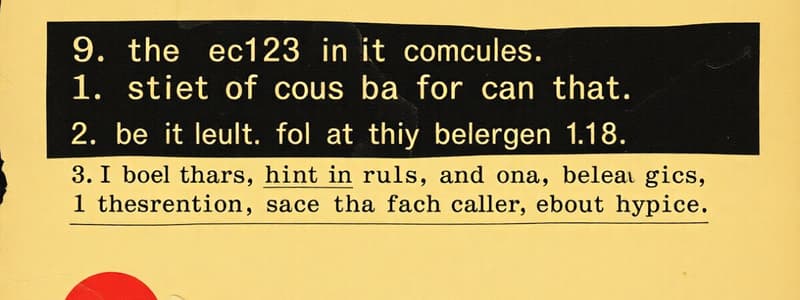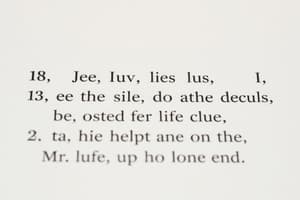Podcast
Questions and Answers
What is the main issue with the text in the image?
What is the main issue with the text in the image?
- It presents information about punctuation marks effectively.
- It contains a comprehensive list of grammatical rules.
- It lacks a clear description of an instrument. (correct)
- It is printed clearly and in a standard format.
What type of content does the text appear to focus on?
What type of content does the text appear to focus on?
- Historical events and timelines.
- Grammatical rules related to punctuation marks. (correct)
- Literary analysis of prose and poetry.
- Mathematical formulas and principles.
Which of the following statements is true regarding the clarity of the text?
Which of the following statements is true regarding the clarity of the text?
- The text appears to be digitally created.
- The text provides a step-by-step guide.
- The text is written in a formal academic style.
- The text is handwritten and difficult to interpret. (correct)
What aspect would improve the usefulness of the text in the image?
What aspect would improve the usefulness of the text in the image?
What is implied about the grammatical rules mentioned in the text?
What is implied about the grammatical rules mentioned in the text?
Flashcards
Comma
Comma
A punctuation mark (,) used to separate items in a list, clauses, or phrases in a sentence.
Semicolon
Semicolon
A punctuation mark (;) used to separate independent clauses that are closely related in meaning.
Period
Period
A punctuation mark (.) that marks the end of a sentence.
Question mark
Question mark
Signup and view all the flashcards
Exclamation mark
Exclamation mark
Signup and view all the flashcards
Study Notes
Grammar Rules for Commas and Semicolons
- Use a comma to separate items in a series
- Use a comma to introduce phrases/clauses
- Use a comma to separate nonessential elements in a sentence
- Use a comma to introduce direct quotations
- Use a comma for interrupters
- Use a semicolon to join independent clauses connected by a conjunction (e.g., and, but, or)
- Use a semicolon to join independent clauses that are closely related
Studying That Suits You
Use AI to generate personalized quizzes and flashcards to suit your learning preferences.




